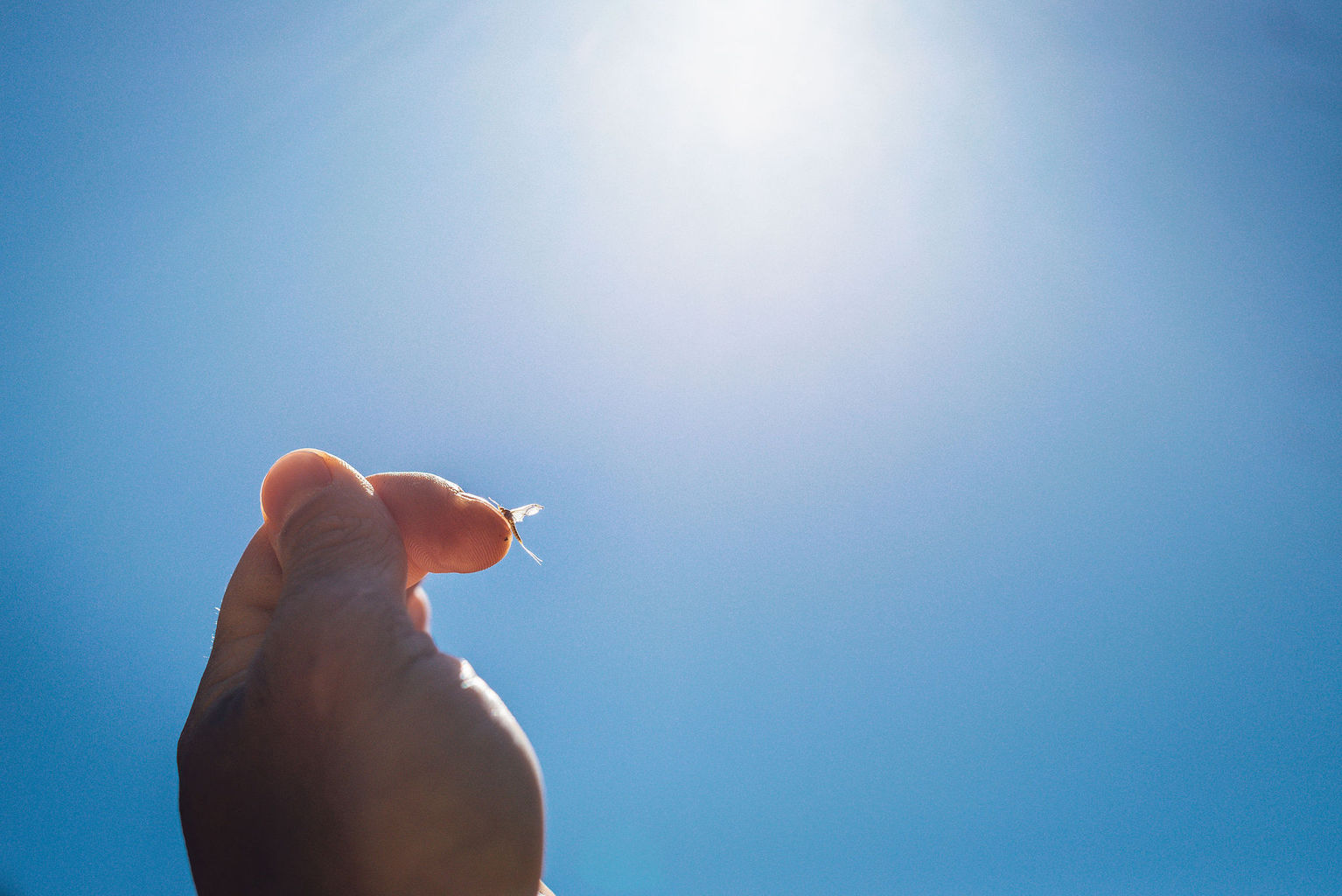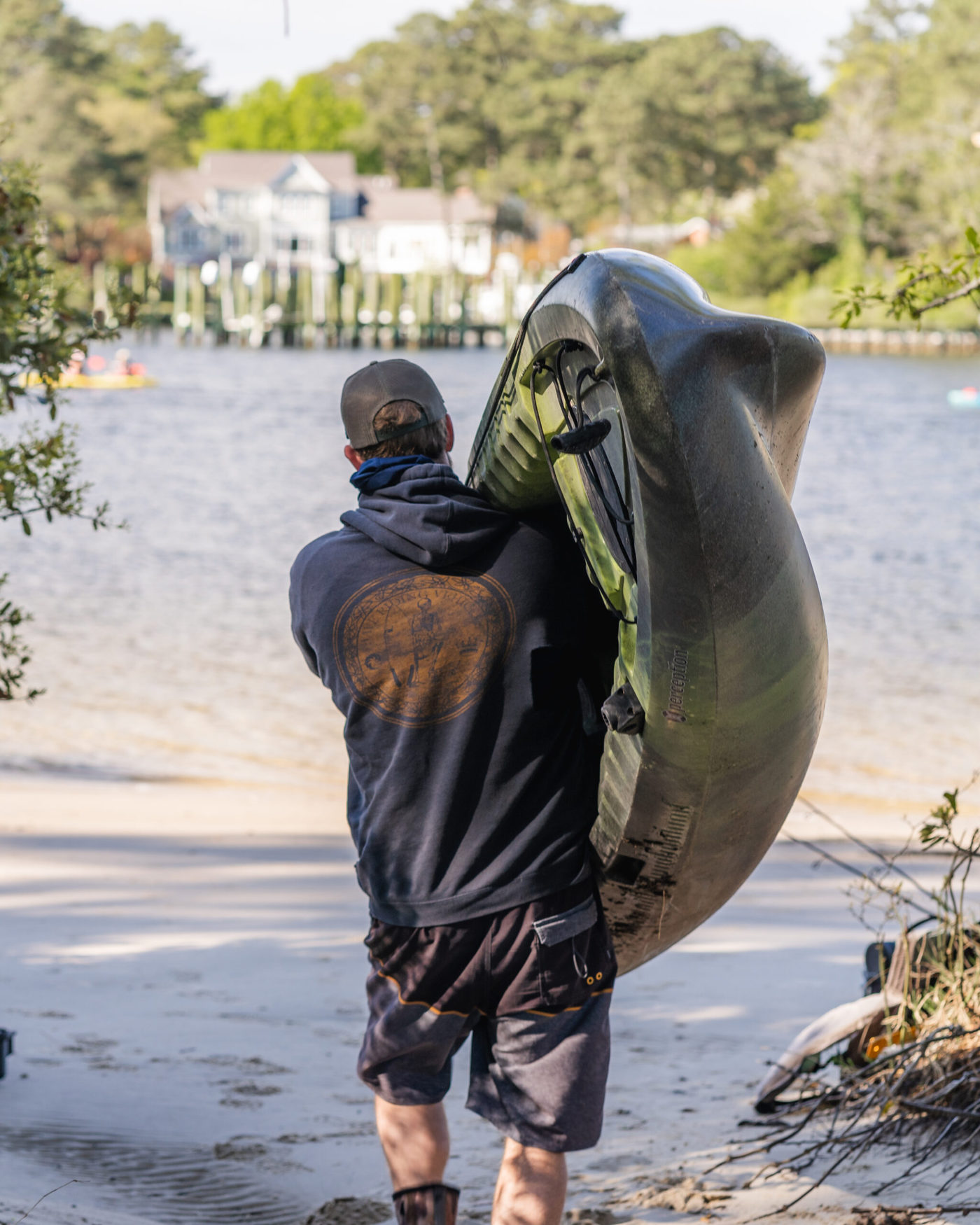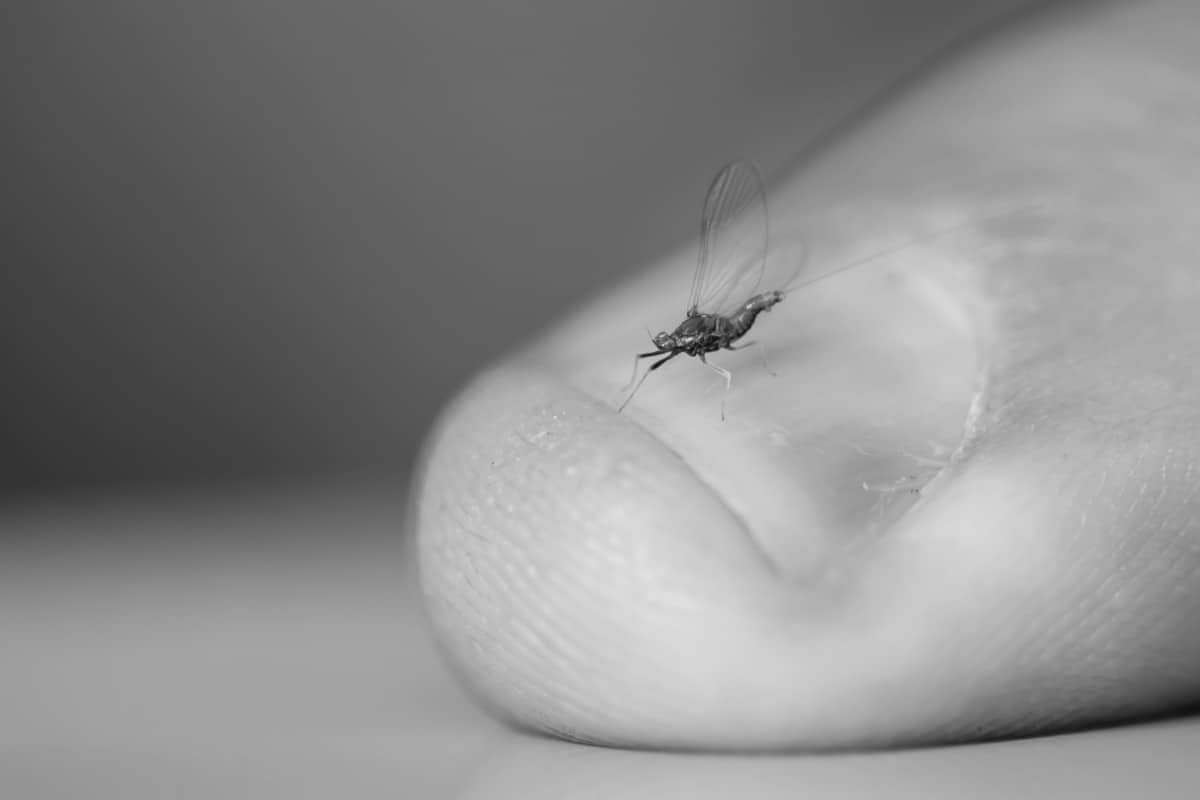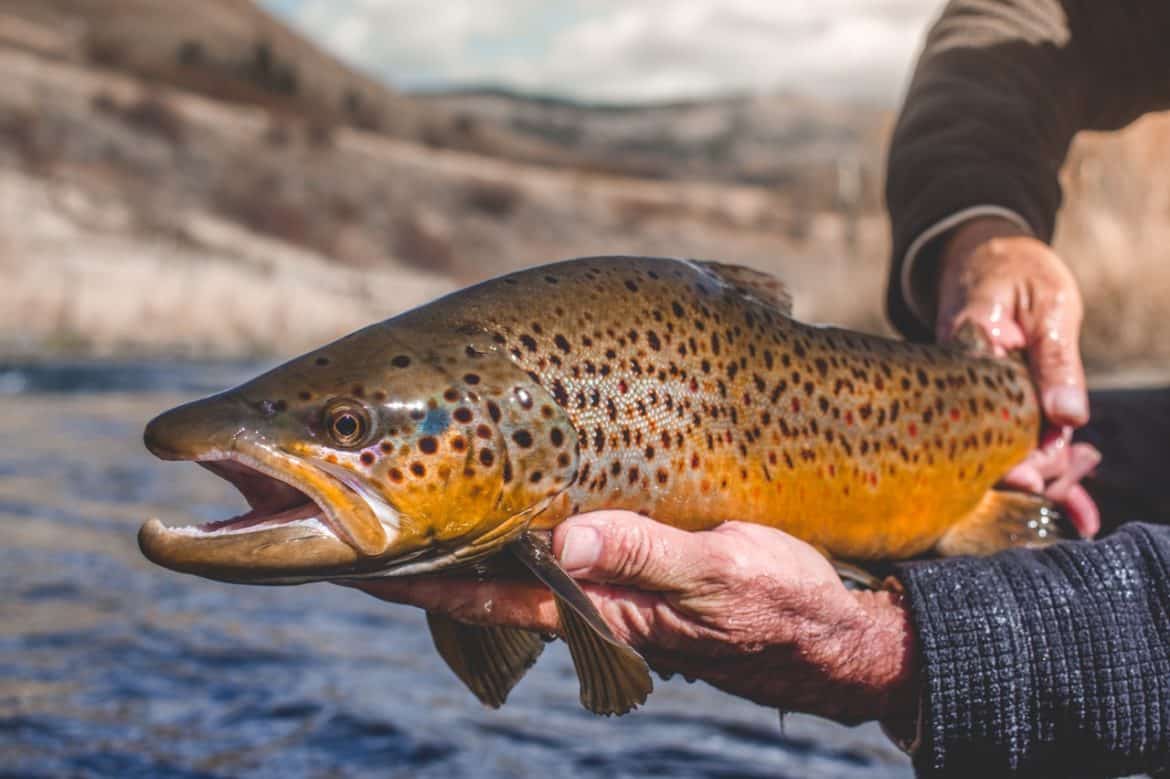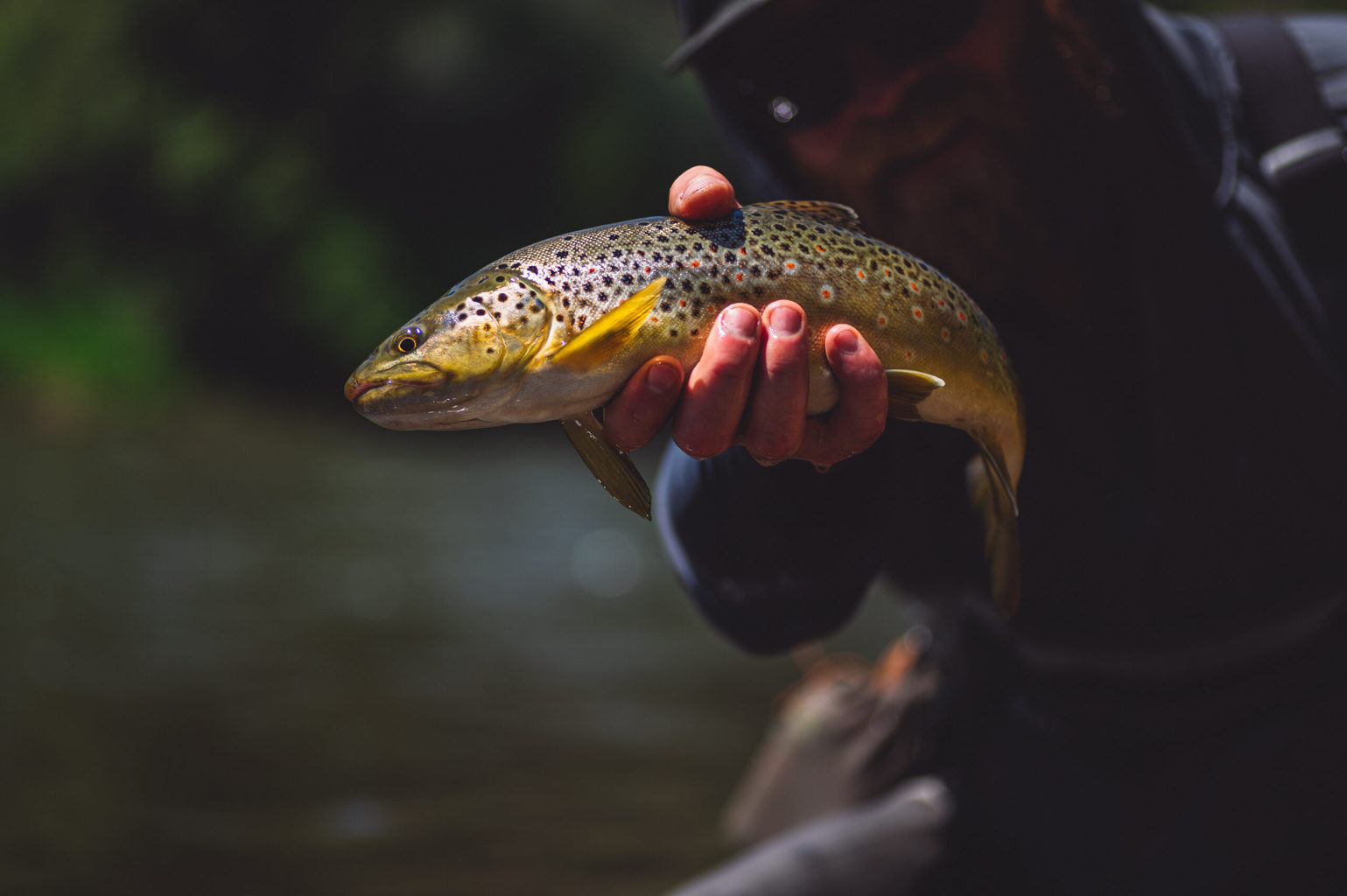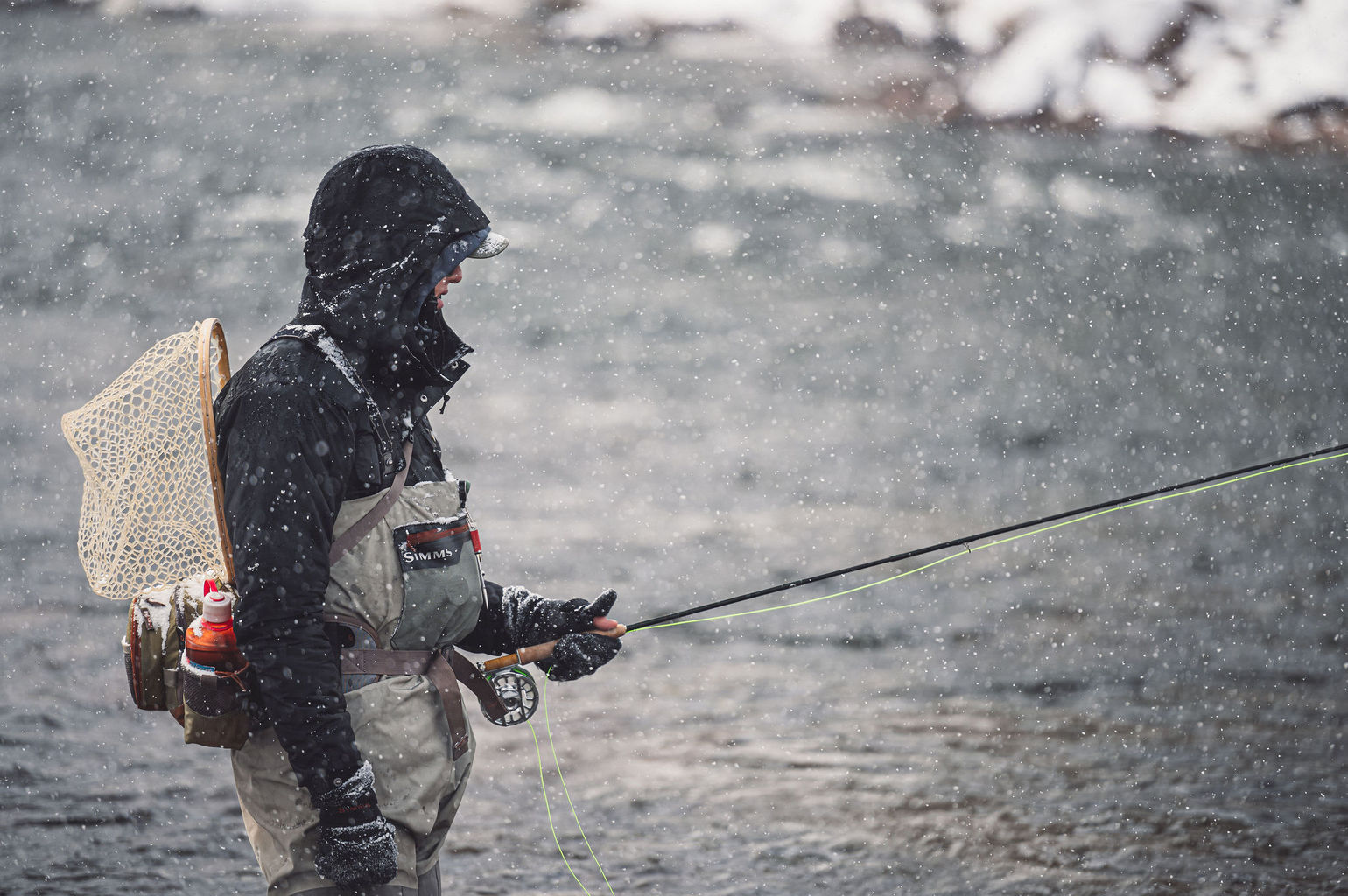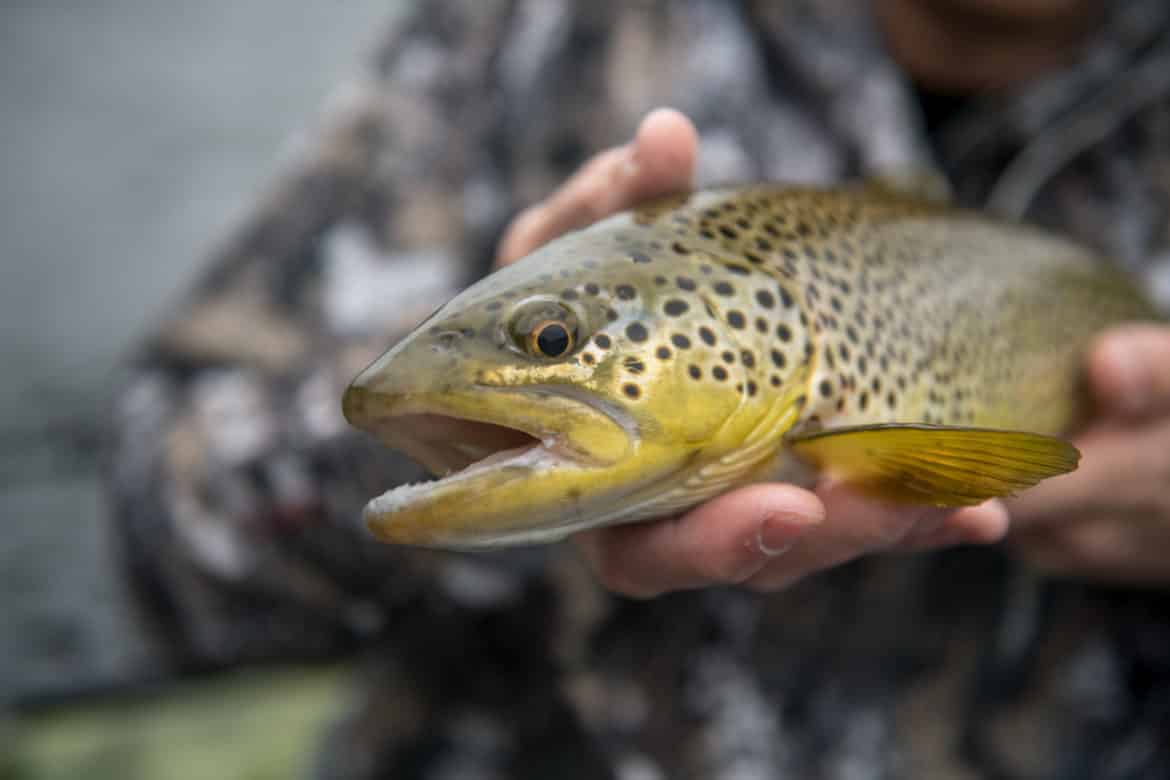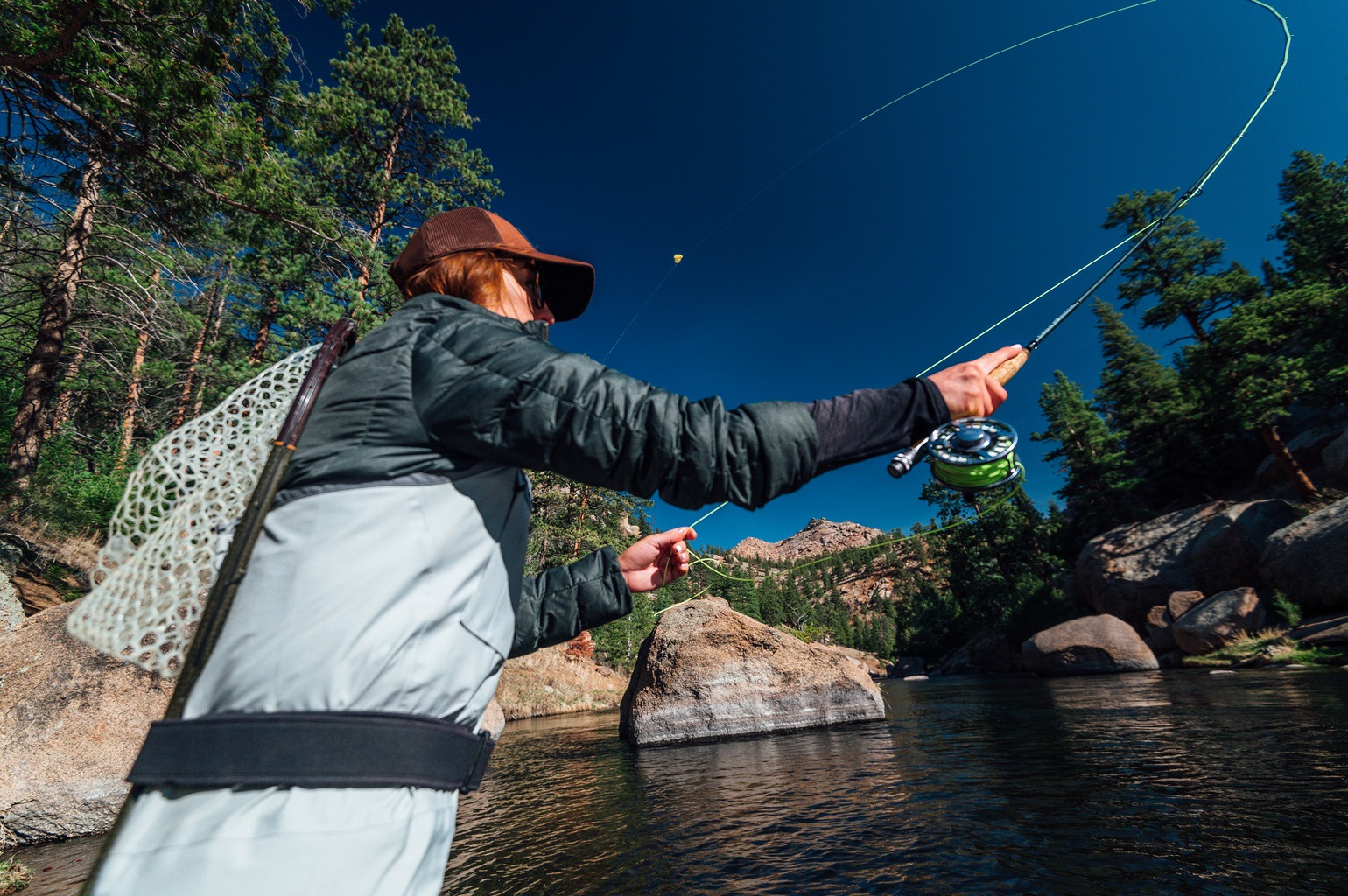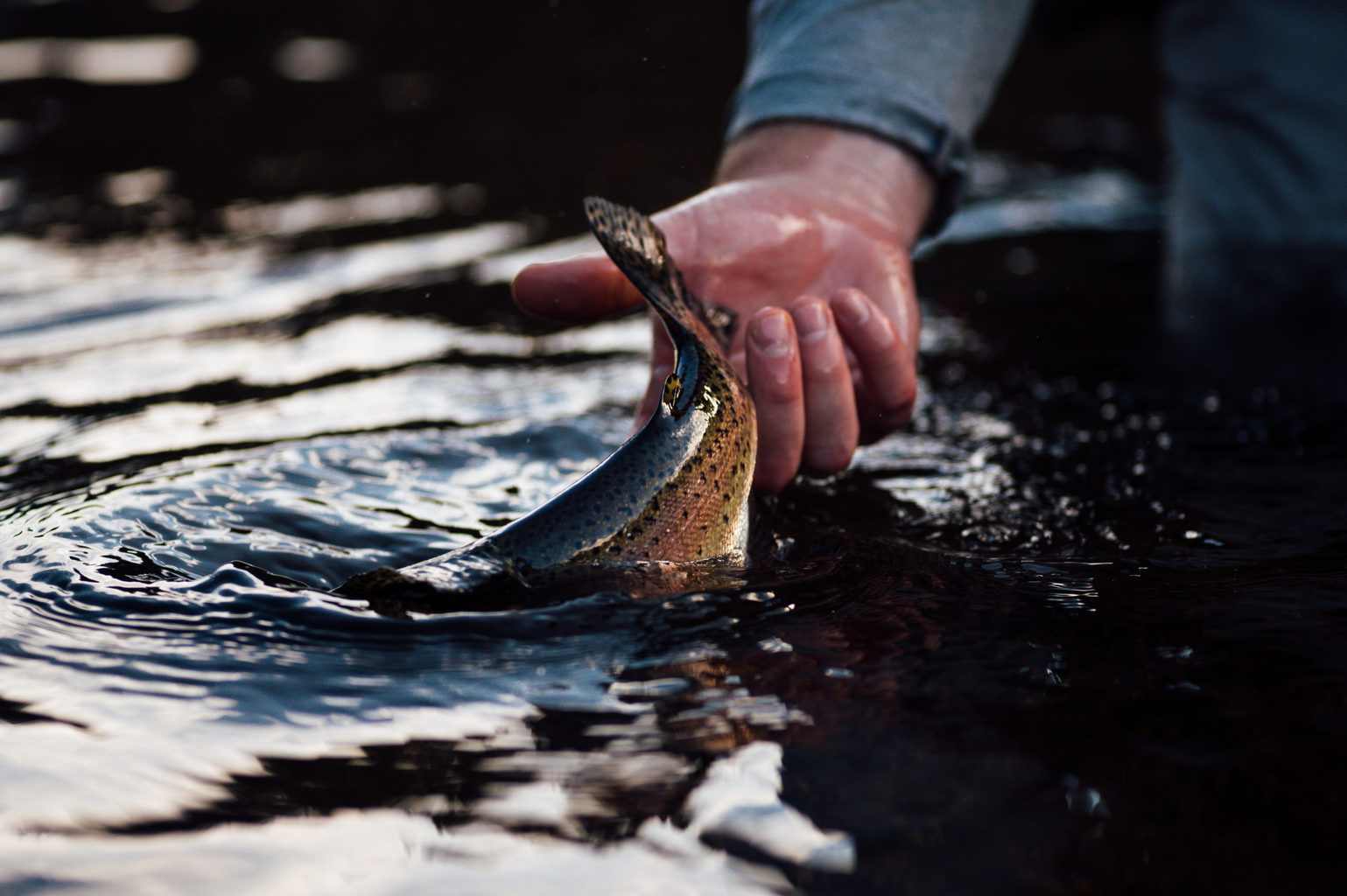How To Fly Fish In The Spring
If you are a fly fishing nerd, then chances are you have been fishing very small flies to lethargic fish all winter long. Spring is nature’s great awakening. Snow turns to rain, trees and flowers bloom, and the fish start to wake up too. For fish, this is an internal desire to find spring time spawning grounds. It’s time to take advantage of increased food sources. Water temperatures begin to rise which is the ultimate signal to fish that their time has come. This gives anglers ample opportunities too.
Spring fly fishing is an excellent is chance to score an early season big fish. Although trout fishing is a complicated art form, a sport we will never master, we are going to discuss some of the intricacies of spring fly fishing. The goal is to help anglers better understand the spring fly fishing eco system. We are going to discuss spring time fly fishing tactics, insect activity, where fish will hold, dealing with runoff, muddy water, and everything in between.
Table Of Contents
Spring Time Fish Behavior
As fly anglers, we should approach a river with a fish’s natural instinctive desires in mind. Whether it is early spring or fall, fish have one goal: it is to survive and pass on their genes. All animal behavior is rooted in, influenced by, and driven by this principle. For anglers, this means sex and food sources dictate where trout will live and their daily behavior.
Water temperatures are cold in early spring. This means that fish will be in a lethargic state. They will be holding in deep slow pools. Cold water temperatures, rich with dissolved oxygen, affect trout and their dietary patterns. Trout cannot regulate their body temperatures, so as the water temperature drops they become sluggish and lethargic. In addition, the only insects hatching this time of year are midges and the occasional mayfly. There isn’t much to eat and the focus is on conserving energy and surviving the spawn. These factors combined put early season fish in a state of hibernation and thus they will be holding in slower water.
As water temperatures start to increase, fish will become more active. In addition, there is an increase in food sources in the water column. River temperatures are a major factor in insect activity. There are several magic numbers for water temperatures that anglers should remember for early spring fly fishing. By keeping track of water temperatures, fly fishermen can predict and take advantage of upcoming hatches.

Blue-winged olives will usually be the first insects other than midges to hatch. These early season may fly hatches give hungry trout their first opportunity at a significant food source. B.W.O.’s hatch in large numbers and they spend a rather long time on the surface of the river drying their wings. This can make for some excellent dry fly fishing. The magic water temperature number to start the hatch for blue-winged olives is 48 degrees.
In addition to mayfly hatches, anglers will also begin to see the first caddis fly hatches of the early fishing season. The Mother’s Day Caddis hatch is a prolific and famous hatch on most rivers East and West. Mother’s day caddis need a water temperature of 54 degrees. This is a prolific hatch, and the surface of the river can be covered in small black caddis. This also gives anglers an excellent early season opportunity for dry fly fishing.
The last hatch and one of the most important are the salmon fly and golden stone fly hatches. These large crawling insects offer trout huge amounts of calories In a short period of time. The magic water temperature for salmon fly and golden stone fly hatches is 55 degrees. These large insects crawl on the bottom of the river towards the banks.
As water warms and more food is pulled into the river system, trout now have a reason to leave the safety of deep water holding areas, and move into feeding lanes that are less safe but provide better access to food. For this reason, fish begin to move into shallow flats, riffles, pocket water, and the back sides of shelves. Rising fish sipping BWO’s or mothers day caddis in shallow flats can be easy targets for fly fishers as well as birds of prey. That being said, for trout, the opportunity to eat a large number of calories after a long winter outweighs the risk of being eaten by an osprey or caught by an angler.


Salmon flies and stone flies migrating to the banks will pull fish there as well. Most trout will follow their food source, so finding fish in the spring has a lot to do with which insects are hatching. This is the best chance of the year for anglers to fish flies that are large and made of pieces of buoyant foam. Many large trout are caught this time of the year. They are willing to eat large gaudy flies. Big trout eat big meals. This is their moment. Abundant opportunities at high calorie meals are not chances that trout often pass on. This is especially true with the spawn right around the corner.
Sex is the other driving factor that dictates where fish will be found in the spring. Rainbow trout and Cutthroat trout spawn in the spring. Trout are salmonids, so just like their ocean going cousins they swim into tributaries and spring creeks that feed the main river to spawn and lay their eggs. They lay eggs in what is called a redd. This is an area of gravelly river bottom that the female has cleared of debris with her tail. This is her nest where she will lay her eggs.
As trout migrate out of lakes and the main river system, many large fish can be found in small bodies of water. Anglers need to be careful this time of year. It is unethical to catch nesting fish that are actively nesting on redds. In addition, you should never wade through a redd and destroy the eggs. After the spawn is over, these fish will return to the main river channel. Due to this yearly migration, many of the larger fish in early spring will be out of the main river ecosystem and can be found in creeks and feeder channels.

How Do You Match Flies to the Hatch?
When a “hatch” is happening it means that aquatic insects found in the stream, river, lake, or pond are emerging from the water in great abundance. Usually, you’ll find insects drifting on or taking flight from the water’s surface. Take a look in the tall grasses, bushes, rocks, and trees streamside to get an idea of what may be emerging. You may find nymphal shucks scatter along the rocks or drifting within the surface film.
If you can see trout feeding you will be able to get a reasonable idea of what is hatching just by looking at their rising behavior.
Splashy takes that happen with speed are usually trout rising quickly from a great depth. They rise from whatever deep hiding place they were holding at and swim rapidly up to take it right before it drifts by. In many cases, it takes caddis pupa to swim to the surface. Caddis pupas are fast swimmers and take flight within the blink of an eye. So trout need to be quick or they’ll miss their meal. But we’ve witnessed these explosive strikes on every insect hatch, not unique to just caddis emergences.
Rings
When you spot trout barely breaking the surface making soft rings, these are very gentle takes. This means that they are feeding actively extremely close to the surface and whatever they are feeding on isn’t moving or going to fly away — usually dead, just hatches, or dying insects. When you spot soft gentle takes leaving little air bubbles in the surface film, you can bet that trout are feeding on mayfly spinners, mayfly duns, and crippled insects. Trout will also rise to midges in this same fashion.
Porpoising
This is the classic rise that you see where the trout’s snout is seen first and then the dorsal fin. A porpoising rise can be seen in any insect hatch and doesn’t really tell you much about what specific insect they are keying in on but where they are within the water column. Porpoising rises mean this trout is close to the surface and has been or will be feeding for some time. It feels comfortable being that high in the water column and is most willing to opportunistically take food drifting by. A great candidate for sending a well-placed dry fly a few feet upstream.
The other way to know exactly what’s hatching is to survey what insects are in the water and the surrounding stream bank.
Carrying a small bug seine in your vest is a handy tool to have when you’re not sure what’s floating around in the water. Fan this out in the water to net up any nymphal shucks and insects drifting by. Survey what you’ve caught and get a good idea of what flies you might start with. In many cases, you’ll find multiple hatches going on at the same time, which is not a problem at all to weed through. Grab a fly pattern imitation of each hatch and tie on multiple flies at once. Let the trout tell you what they’re after. Once you get a strike or a trout follows your fly, double down on that hatch and add another variation.

How To Fly Fish High Muddy Water
As the water temperatures rise, this means that ambient air temperature is also rising. In addition, spring also brings less snow and more rain. When rain and warm air temperatures start to occur simultaneously, this will kick off spring runoff. All those early spring time hatches and early season rising trout will suddenly disappear. Murky water with a rise in water level will put fish off for a while.
Where To Find Fish In ‘Blown-Out’ Conditions
Fish are creatures of habit. Trout will get into a holding area and will stay there until it is unsafe, the food disappears, or water levels high or low make it uncomfortable for them. They will move to a new area that is comfortable, get situated to feed and resume their regular patterns. High water makes normal holding areas uninhabitable. Often times swift water flows leave few places for trout to hold. They will seek slower water toward the banks, slower back eddies, and any place where they can get out of the current.
Early season high murky water is a blessing in disguise, it concentrates fish into small areas of the river. For discerning anglers, if you are able to find slower currents in side channels, back eddies, slack water near the banks, and any other slow currents, there will probably be large amounts of fish holding in those locations.

When fishing nymphs, use heavier flies or split shot to dive through the increased flows deep along the bottom. This is where the trout are – hugging the bottom. Believe it or not, the streambed impedes the flow of the water and slows currents.
Trout are like most creatures, they want to feed in the easiest way possible. During high flows and murky water, trout won’t be found in the fastest currents. Instead, they will go deep seeking out a structure and soft pockets to take refuge in. Look for fallen trees, branches, beaver dams, and boulders that break the flow and provide eddies, side-pools, and soft pocket water. Casting around these areas and several feet below will be ideal fishing spots.
Seams, where bubble trails are funneled into, are also great places to find trout. Water seams form where slow water meets fast water, sometimes even forming a swirling pool. You’ll regularly find these off to the sides of the stream and large boulders.
Fish Larger Sizes
Spring fishing in murky water greatly reduces a fish’s visibility to see flies. This means fly anglers can utilize floating lines with strike indicators to nymph big flies deep. Big flies offer a larger profile, making flies more visible to fish. Generally speaking, there are larger food sources in the water during spring runoff. Try fishing one or two sizes larger than what you typically use. For example, fish a size #12 or #14 if you’re usually fishing a size #16 nymph.
During runoff, there are several food sources that are important for spring fly fishing. As we mentioned earlier, cutthroat and rainbow trout are actively laying eggs. When river levels rise eggs are flushed out of redds and they become an excellent source of protein for other trout. Furthermore, as water levels rise and creep up banks, worms are washed into the river with the erosion of river banks. If you are fishing a tailwater stream, crane flies can also be an excellent food source for trout. Large stonefly nymphs are an option as well.
All of these food sources make great choices when choosing fly patterns for fishing early season runoff. A floating line and nymph rig with an indicator is your best option this time of the season. Dead drifting big flies in slower water is where you want to concentrate your efforts. This is the time to fish flies such as pink squirmy worms, or a pat’s rubber leg with a fluorescent hot spot. Egg patterns are also many anglers’ springtime favorite flies to choose from.
I prefer to fish a two-fly nymph rig this time of year. I usually go with a size 4 or even 2 Pat’s Rubber Leg and fluorescent Pink Squirmy Wormy as my second fly. Consider adding a split shot because getting the flies deep and in the strike zone is critical to catching fish. The fast deep water current requires heavier weight to get the flies to depth, especially when fishing banks.
Find The Tributaries
When the main stems of streams are still coming up and clarity is getting worse, anglers should find those tributary streams that clear up sooner.
Not only will these smaller watersheds run off quicker, but by fishing main sections of streams above the tributary, you are effectively cutting the runoff (and clarity issues) down. As a general rule of thumb, the more off-color the water is, the further upstream you should go. Get above those tributaries, or fish them!

Fish Deep and Flashy
The upper water columns are usually filled with the debris during rain events resulting in off-color water.
That’s easy to see as twigs, branches, and leaves come drifting by in the current. Anglers can combat this by getting their flies down deep and using flashy patterns. Flies with plenty of flash work especially well in these situations. Rainbow warriors, wooly buggers, and certain stoneflies work fantastic when the water is off-color. By fishing them in a multi-nymph rig anglers can effectively cover the bottom of deeper holes and runs where trout will be hunkered down waiting for the water to clear.
Fish Water You Know
Of all the challenges facing anglers in off-color water, perhaps none are as daunting as the inability to accurately gauge water depth. Runs and drop-offs are indistinguishable in poor condition, but this hardship can be lessened by fishing water you know. Those little pockets of depth and deeper channels will be known in even the murkiest of water. This can help save time probing from spot to spot finding appropriate depth and make it so that every cast is in the fish zone.
One of the joys about fishing water that is off-color is other anglers are quick to pack it in and head back home to try agai

How To Rig Your Fly Fishing Rod For The Spring
There are many different ways to rig up your fly rod for spring fly fishing. Obviously, this depends on where you fish, the type of water you are fishing, and the water flows. This is different for every angler. That being said, here are three of the best ways to rig your fly fishing rod to use for spring fly fishing.
Rig 1: Nymphing For Big Trout
We briefly covered it above, but when water is high and dirty, you are most likely going to want to nymph big flies down deep. This is a great opportunity to fish heavy 3x tippet and even 2 x in some cases. I usually go with a 7.5ft 2x leader and then add an 18″ to 24″ 3x fluorocarbon tippet section.
Throw a large bobber 1.5 times the depth of the river to get it deep into the water column. My first fly is a large Pat’s Rubber Leg in size #4 and then a Pink Squirmy Worm or Otter Egg. This is an excellent opportunity to catch a big fish. In my experience guiding, most large trout are lost because poor hook sets with small flies result in a marginal hookup and a lost fish. These larger fly patterns give anglers a better hook set so strong fish cannot straighten or twist these thicker hooks out of their mouths.
Recommended Reading: Nymphing Flies to Trout in the Spring

Rig 2: Rigging Up For Stoneflies
When the western stonefly Salmon fly hatch is happening there are an abundant amount of golden stone flies and salmon flies on the banks. This is an angler’s opportunity to fly fish with large foam flies. I find that the best approach here is to start with a single large foam fly, like a Chubby Chornobyl. You want to get it as tight to the bank as possible. Use a 7.5 ft 3x leader. This shorter leader will turn the fly over and allow accurate casts to the bank.
Look for grassy banks. This is where salmon flies and golden stones will congregate to mate. If you are not losing flies, then you are not fishing close enough to bank and structure. If you are not getting eats on your foam, then you might consider a dry dropper set up. Using your large foam fly as a strike indicator, tie 3x flurocarbon to the bend of the hook of your foam fly. Choose a length of tippet depending on the depth of the water that you are fishing. In some cases I’ll use up to three feet for the dropper fly. The reason for this, is that by manipulating your rod tip, you can swing a rubber leg nymph under over hanging bushes and into under cut banks. This can be a very effective method to catching fish that won’t eat a foam dry fly.
Recommended Reading: How to Catch Trout on Stoneflies

Rig 3: Standard Dry Fly Fishing
A standard dry fly fishing setup is important for early spring fly fishing outings when BWOs or caddis are on the water. I typically go with a 9ft 4x fly leader and add a section of tippet from there. You could use more 4x but will probably be using 5x or even 6x tippet depending on the size of the insects that are hatching. The longer the leader the less accuracy you will have, but it will give you a drag-free drift.
I prefer to use fluorocarbon tippet in almost all my rigs, even when fishing dry flies. The reason for this is that fluorocarbon sinks. Whereas, regular monofilament will float. Floating mono lays on the water, and the line creates dimples on the surface of the water. Whether or not it is in my own imagination or not, I believe that I have seen weary fish refuse a fly because of the dimples on the water. Always go with what you have confidence in.
A two-fly rig is always a good place to start. In hatch specific cases, I use a standard dry fly as my point fly. During a B.W.O.’s hatch, I would use a Parachute Blue-Winged Olive, and then from the bend of the hook I would add 18″-24″ of tippet and would fish a small size #20 or #18 Pheasant Tail Unweighted. Brush the Pheasant Tail with dry fly floatant. With this rig, you can now present the fly to both trout feeding on the surface, and to fish feeding in the meniscus on emerging B.W.O.’s.
Recommended Reading: How to Fly Fish With Dry Flies For Trout
Tips For Fly Fishing In The Rain
Yes, you can still catch fish while fly fishing in the rain.
If you could be privy to fly shop guide huddles, then most rainy or cloudy mornings you would hear them mumble under their breath “this is just perfect.” Most of us would like warm sunny days, but the reality of spring and fly fishing, in general, is that weather is going to be an important factor in angling success. While most people and most clients want to leave the river when the precipitation starts to fall, this can be an excellent opportunity to take advantage of a blockbuster day of fishing. Fish and insects alike are greatly affected by light and water temperatures.
Spring precipitation will often bring increased hatches and increased feeding. There are several reasons for this. First of all, fish don’t have eyelids, so they are extremely sensitive to light. This means when it is sunny outside, fish have to look up into a bright sun. They cannot see food on the surface of the water. It is uncomfortable for them.
Fish Feel Less Threatened
Secondly, raindrops on the surface of the water, and low light conditions create distortion on the surface of the river. This allows fish to move more freely without the risk of being eaten by predators. They can see and confidently feed on food.
Hatches Last Longer
In addition to fish being more active during low light, insects are too. Typically, on bright spring days, insects will hatch during the warmest part of the day. The hatch on a bright day is short and well-defined. On rainy or cloudy days, hatches tend to be long and drawn out with an increase in insect and fish activity. Furthermore, the more moisture that is in the air makes it harder for insects to dry their wings and fly away. This creates more food on the water for longer periods of time. This is your opportunity to take advantage, while other fishermen will head for the truck.
Fly Fish Worms, Beetles, Ants, And Eggs In The Rain
If it really starts to pour and the water becomes murky, then it might be time to re-assess your fly selection and rig. Heavy rain will often wash annelids and other terrestrials into the water. Think about switching to a strike indicator and San Juan worm or egg pattern when the rain really starts to fall. Fishing in the rain can be epic.

Where Are Trout Most Commonly Found?
Trout actively feed several times per day and are much easier to catch than those that were spooked by you or other predators. So your best chances are to target feeding zones or to trout visibly feeding.
But just because you see trout doesn’t mean they will feed.
Like those ones, you see lying low in the deep pool along the bridge pillars or in a big sandy bed. Most trout in extremely deep water are not feeding. In fact, it’s most likely resting or hiding. Most of those deep pools are simply not ideal for feeding because food is scarce there and very little drifts through those areas. Instead, trout will move to other areas that are more optimal for feeding that funnel food right in their direction.

So let’s narrow down where you’ll find feeding trout.
Trout like to feed in areas where the current is not so fast where they burn a lot of energy but just fast enough where food drifts to them at a decent rate. Usually flows moving at the pace of a slow walk is roughly the optimal speed.
A water depth from 2-feet to 4-feet is where we find most feeding trout. You may find trout in more shallow water depending on conditions and how much fishing pressure the stream gets. I’ve seen trout feeding in about 12-inches of water during a Blue-Winged Olive hatch right along the shoreline or at the edges. So just be aware of these outliers and take advantage of them before placing casts to the rest of the pool.
In areas where fast water meets slow water you’ll find a noticeable line, usually where a line of bubbles or debris collects, called a seam. Trout will hug this line because seams funnel all sorts of insects that have hatched in the riffles above or fallen in. A well-placed nymph can also be drifted through these seams to trout hanging low along the bottom. Fish the inside edge of seams first and then cast closer to the middle before targeting the main current.
Shade is also a great place to find trout. Trout find safety swimming within a shaded section of the river and will often choose to feed in these sections to avoid the prying eyes of a predator. Or they will use these shaded sections as a hiding spot to ambush prey from and then quickly return to. With an accurate cast, you can place your flies just on the outside or inside of the shade to lure trout up to take your fly.
Eddys are swirling currents caused by flows passing over and around obstructing objects such as large boulders or submerged rocks. As the water passes around these objects, it creates a reverse current that pushes it into a swirling motion or a slow patch of water. These places can be small or quite large amassing a pile of debris and foam. Slow pockets of water like this are great holding areas for trout who like to pick off insects that drift by in the faster current. They like to swerve in and out of this safe pocket of water and into seams created by the eddy against the faster flow.


Feeding trout will stay a few feet away from areas where they can ditch back into for safety if they sense a predator. Fallen trees, shade, boulders, overhanging banks, deep water, and riffles are common hiding places. Use these places as markers to help pinpoint where you might find a few fish.
When it comes to fishing these areas, try using a grid method. Separate the main current into multiple threads or grids and fish the ones closest to you first. We prefer to position ourselves downstream and cast up. An upstream presentation helps stay out of their line of sight and gives us a better angle to cast. Approach as if you’re stalking the trout nice and slow. Use the natural noise of the stream to add some stealth. For example, wading through fast flows and riffles will help disguise your entrance.
Now, closely watch where the water flows into and where trout might quickly find cover but still be able to feed off the channel. Place your fly several feet upstream and let it drift down. Actively mend your fly line to avoid dragging your presentation.

How Do You Know What Size Tippet To Get?
Knowing what size tippet to pair with your flies is just as important as your fly selection. The thickness of your tippet can make or, quite literally, break the quality of your presentation.
Thicker tippet sizes (0X – 3X) are stiff enough to roll over and cast heavier flies with greater accuracy. Not only that, but bigger flies usually mean larger fish so these thicker tippets will provide higher poundage to avoid losing your personal best catch to a weak knot. Use 3X or thicker tippet for any flies as large or bigger than a size #8. This includes streamers, poppers, and bass bugs or casting to large fish.
I would not recommend using these large sizes for tiny flies simply because their thickness would prevent a natural drift. For example, casting tiny size #20 tricos on a slow-moving pool with a 2X tippet would not be able to dead-drift naturally were a 6X or 7X would shine.
Mid-Range tippets (4X – 5X) are ideal for small streamers and nymphing rigs. These sizes are not ideal for casting big flies and are best suited for flies smaller than #8. It’s not that 4X or 5X is too light of poundage to handle big fish, it’s simply that they may be a little too flimsy for curling heavy streamers easily.
Thinner tippet sizes (6X – 7X) are perfect for small flies and delicate casts. When casting to rising trout requires a soft presentation to avoid spooking them, use these thinner sizes. The fineness of these tippets allows your rigs to drift naturally with the microcurrents and float gently onto the water without disrupting any active feeding.
- 0X – 3X Tippet: Ideal for size #8 and larger flies to catch bigger fish.
- 4X – 5X Tippet: Ideal for smaller streamers and nymphing rigs. Very versatile for size #8 to size #20 flies.
- 6X – 7X Tippet: Ideal for small flies and delicate casts. Recommended for size #12 to size #22 or smaller.
What tippet is best for dry fly fishing?
We’ve found that the ideal tippet size for dry fly fishing is 6X. Typically, we use 5X, 6X, and 7X tippet for dry flies simply because it provides the gentle presentations we need to make soft casts to timid trout and natural-looking dead drifts.

Best 10 Flies For The Spring And How To Fish Them
While every angler has their own favorite fly patterns, these are my 10 favorite fly patterns for my springtime fly box. I always like to have a few old standbys that always work for me, and then a few new ones to experiment with.

Double Bead Squirmy Worm
Nymph this fly under an indicator. Pink is our favorite spring time color when fishing during runoff.

Bead Head Veiled Cabalerro
Fish this fly in tandem with a squirmy worm to take advantage of spawning spring time rainbows and suckers. The two toned egg gives this fly a realistic appearance.

RS2
The RS2 is a versatile fly that can be used when choosing small nymphs or emergers for spring fishing. It can be nymphed deep or fished as an emerger in the surface film

JuJu Bee Midge
Don’t over look the midge hatch. Even though other insects are hatching on the river, they are important all year. The juju bee midge can be nymphed deep under a strike indicator or fished on a greased tippet behind a dry fly as an emerging midge.

Pat’s Rubber Leg
Fish these all year round. Choose sizes in #4,#6 and #8 for early spring. They make a great point fly when nymph fishing under and indicator. Heavily weighted they get the flies down deep and into the strike zone.

Unweighted Pheasant Tail
Choose smaller sizes in #20 and #18 for spring time fishing. These are excellent patterns that can be fished in various depths of the water column as a nymph or emerger. Smaller sizes will cover the spring baetis hatch.

X-Caddis
Other than an elk hair caddis, the x-caddis emerger is one the best caddis dry patterns out there. Smaller sizes in black and brown should be in your fly box for spring fly fishing. This pattern is fished like a traditional dry fly. It sits low in the water and straddles that fine line between adult caddis and emerger.

Simple Baetis
The Simple Baetis pattern can be nymphed to difficult fish taking baetis lower in the water column. It can be nymphed deep with a tightline technique or tied on as a dropper on a dry fly setup.

Chubby Chernobyl
The Chubby Chornobyl is a large foam fly that can be fished on extra heavy leaders and tippet. This fly is ideal for fishing the Salmon Fly and Golden Stone Hatch. Cast this fly close to banks and into bushes. It is also an excellent option as a point fly for dry dropper setups.

Adams Parachute
The Adams Parachute is an excellent pattern that transcends both caddis and mayfly hatches. The nymph and dry forms are both must haves in your fly box year round. The parachute version of this fly is fished as standard dry fly. The weighted nymph version can be fished as a dry dropper or under a indicator t deeper fish.
Fly Fishing Made Easy 👍
Our Quarterly Fly Club ships 1,000’s of flies to anglers all across the United States. Receive curated fly assortments selected for the season with in-depth articles on how to fish them. Great for beginners to learn and for intermediates to discover new flies.



